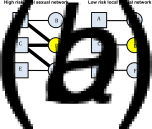The role of sexual networks in studies of how BV and STIs increase the risk of subsequent reinfection
- PMID: 30182860
- PMCID: PMC6452990
- DOI: 10.1017/S0950268818002157
The role of sexual networks in studies of how BV and STIs increase the risk of subsequent reinfection
Abstract
Prior studies have demonstrated that both bacterial vaginosis (BV) and sexually transmitted infections (STIs) are strong independent risk factors for subsequent STI. In observational studies of this biological enhancement (BE) hypothesis, it is important to adjust for the risk of STI exposure so that the independent effect of BE can be assessed. We sought to model if two markers of local sexual network (partner concurrency and cumulative number of STIs) represented residual confounding in the models of risk for subsequent infection in a study that screened 3620 women for STIs every 3 months for a year. Mixed-effects logistic regression was used to calculate the odds ratios for an incident diagnosis of Chlamydia trachomatis, Neisseria gonorrhoeae, Trichomonas vaginalis and BV following a diagnosis of any of these four at the prior visit, controlling for the cumulative number of STIs and partner concurrency variables. We found that partner concurrency and cumulative number of STIs were each associated with incident infection, and in general, controlling for these variables reduced the strength of the association between prior and incident infections. We conclude that the frequently found association between prior and incident STIs is associated with both BE and sexual network structure.
Keywords: Bacterial vaginosis; Trichomonas vaginalis; chlamydia; gonorrhoea; partner concurrency; residual confounding; sexual network.
Figures


Similar articles
-
Perceived stress and incident sexually transmitted infections in a prospective cohort.Ann Epidemiol. 2019 Apr;32:20-27. doi: 10.1016/j.annepidem.2019.01.010. Epub 2019 Jan 26. Ann Epidemiol. 2019. PMID: 30799204 Free PMC article.
-
Subsequent sexually transmitted infections among adolescent women with genital infection due to Chlamydia trachomatis, Neisseria gonorrhoeae, or Trichomonas vaginalis.Sex Transm Dis. 1999 Jan;26(1):26-32. doi: 10.1097/00007435-199901000-00005. Sex Transm Dis. 1999. PMID: 9918320
-
Prevalent bacterial vaginosis infection - a risk factor for incident sexually transmitted infections in women in Durban, South Africa.Int J STD AIDS. 2016 Dec;27(14):1283-1288. doi: 10.1177/0956462415616038. Epub 2015 Nov 3. Int J STD AIDS. 2016. PMID: 26538552
-
Bacterial vaginosis-associated vaginal microbiota is an age-independent risk factor for Chlamydia trachomatis, Mycoplasma genitalium and Trichomonas vaginalis infections in low-risk women, St. Petersburg, Russia.Eur J Clin Microbiol Infect Dis. 2020 Jul;39(7):1221-1230. doi: 10.1007/s10096-020-03831-w. Epub 2020 Feb 8. Eur J Clin Microbiol Infect Dis. 2020. PMID: 32036466 Free PMC article.
-
Molecular Identification of Cervical Microbes in HIV-Negative and HIV-Positive Women in an African Setting Using a Customized Bacterial Vaginosis Microbial DNA Quantitative PCR (qPCR) Array.Microbiol Spectr. 2022 Jun 29;10(3):e0222921. doi: 10.1128/spectrum.02229-21. Epub 2022 Jun 1. Microbiol Spectr. 2022. PMID: 35647888 Free PMC article.
Cited by
-
Syphilis Diagnosis After a Chlamydia, Gonorrhea, or HIV Diagnosis Among Reproductive-Aged Women in Baltimore, MD.Sex Transm Dis. 2024 Apr 1;51(4):239-244. doi: 10.1097/OLQ.0000000000001929. Epub 2024 Jan 23. Sex Transm Dis. 2024. PMID: 38301629 Free PMC article.
-
Identification of shared bacterial strains in the vaginal microbiota of related and unrelated reproductive-age mothers and daughters using genome-resolved metagenomics.PLoS One. 2022 Oct 26;17(10):e0275908. doi: 10.1371/journal.pone.0275908. eCollection 2022. PLoS One. 2022. PMID: 36288274 Free PMC article.
-
STI prevalence, incidence, and partner notification among women in a periconception HIV prevention program in Uganda.Int J STD AIDS. 2022 Aug;33(9):856-863. doi: 10.1177/09564624221110992. Epub 2022 Jun 30. Int J STD AIDS. 2022. PMID: 35775125 Free PMC article.
-
Persistence and In Vivo Evolution of Vaginal Bacterial Strains over a Multiyear Time Period.mSystems. 2022 Dec 20;7(6):e0089322. doi: 10.1128/msystems.00893-22. Epub 2022 Nov 22. mSystems. 2022. PMID: 36413016 Free PMC article.
-
Partner notification and treatment outcomes among South African adolescents and young adults diagnosed with a sexually transmitted infection via laboratory-based screening.Int J STD AIDS. 2020 Jun;31(7):627-636. doi: 10.1177/0956462420915395. Epub 2020 May 13. Int J STD AIDS. 2020. PMID: 32403988 Free PMC article.
References
-
- Rottingen JA, Cameron DW and Garnett GP (2001) A systematic review of the epidemiologic interactions between classic sexually transmitted diseases and HIV: how much really is known? Sexually Transmitted Diseases 28, 579–597. - PubMed
-
- Fox J and Fidler S (2010) Sexual transmission of HIV-1. Antiviral Research 85, 276–285. - PubMed
-
- Grosskurth H et al. (2000) Control of sexually transmitted diseases for HIV-1 prevention: understanding the implications of the Mwanza and Rakai trials. The Lancet 355, 1981–1987. - PubMed
-
- Gray RH and Wawer MJ (2008) Reassessing the hypothesis on STI control for HIV prevention. The Lancet 371, 2064–2065. - PubMed
MeSH terms
LinkOut - more resources
Full Text Sources
Other Literature Sources
Medical

